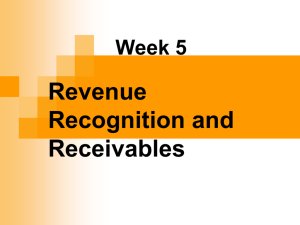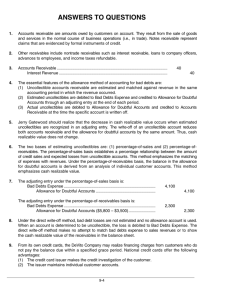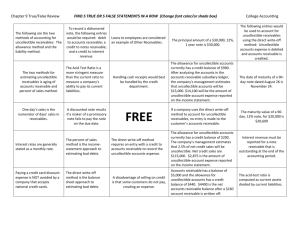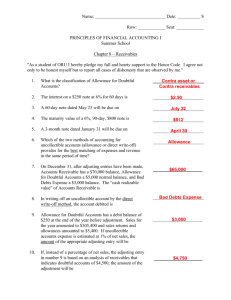Accounts Receivable
advertisement
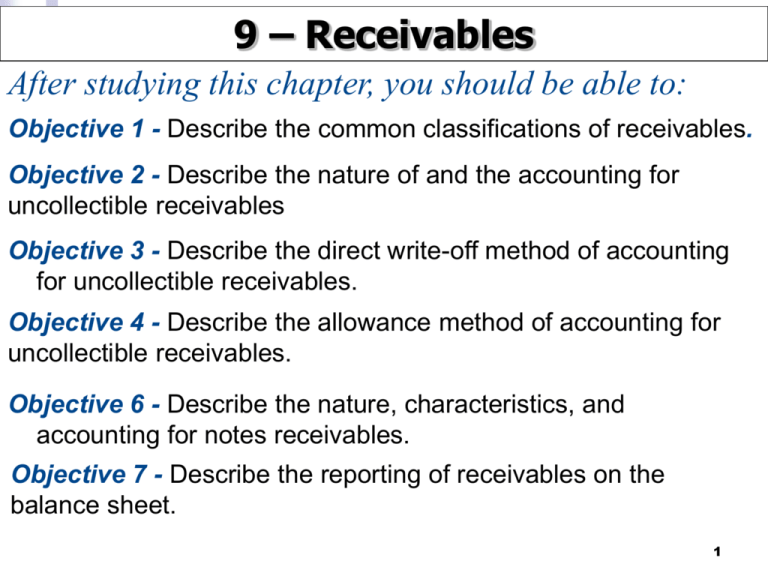
9 – Receivables
After studying this chapter, you should be able to:
Objective 1 - Describe the common classifications of receivables.
Objective 2 - Describe the nature of and the accounting for
uncollectible receivables
Objective 3 - Describe the direct write-off method of accounting
for uncollectible receivables.
Objective 4 - Describe the allowance method of accounting for
uncollectible receivables.
Objective 6 - Describe the nature, characteristics, and
accounting for notes receivables.
Objective 7 - Describe the reporting of receivables on the
balance sheet.
1
Objective 1
9-1
Describe the common classifications of receivables.
The term receivables includes all money claims against other
entities, including people, business firms, and other
organizations.
Accounts receivable are normally expected to be collected
within a relatively short period, such as 30 or 60 days.
Notes receivable are amounts that customers owe for which a
formal, written instrument of credit has been issued.
Other receivables expected to be collected within one year
are classified as current assets. If collection is expected
beyond one year, these receivables are classified as noncurrent
2
assets and reported under the caption Investments.
Objective 2
9-2
Describe the nature of and the accounting for
uncollectible receivables.
Companies often sell their receivables to other companies.
This transaction is called factoring the receivables, and the
buyer of the receivables is called a factor.
Uncollectible Receivables
There are two methods of accounting for receivables that
appear to be uncollectible: The direct write off method
records bad debt expense only when an account is judged
to be worthless. The allowance method records bad debt
expense by estimating uncollectible accounts at the end of
3
the accounting period.
Objective 3
9-3
Describe the direct write-off method of
accounting for uncollectible receivables.
Direct Write-Off Method
On May 10, a $4,200 accounts
receivable from D. L. Ross has been
determined to be uncollectible.
May 10 Bad Debt Expense
Accounts Receivable—D. L. Ross
4 200 00
4 200 00
4
9-3
The amount written off is later
collected on November 21.
Nov. 21 Accounts Receivable—D. L. Ross
Bad Debt Expense
21 Cash
Accounts Receivable—D. L. Ross
4 200 00
4 200 00
4 200 00
4 200 00
5
Objective
4
9-4
Describe the allowance method of
accounting for uncollectible receivables.
Allowance Method
On December 31, ExTone Company estimates that a total of
$40,000 of the $1,000,000 balance in her company’s
Accounts Receivable will eventually be uncollectible.
Dec. 31 Bad Debt Expense
Allowance for Doubtful Accounts
40 000 00
40 000 00
Uncollectible accounts
estimate.
6
Net Realizable Value
9-4
The net amount that is expected to be
collected, $960,000 ($1,000,000 –
$40,000), is called the net realizable value
(NRV). The adjusting entry reduces
receivables to the NRV
7
9-4
On January 21, John Parker’s account totaling
$6,000 is written off because it is uncollectible.
Jan. 21 Allowance for Doubtful Accounts
Accounts Receivable—John Parker
6 000 00
6 000 00
To write off the uncollectible
account.
8
9-4
During 2008, ExTone Company writes off $36,750
of uncollectible accounts, including the $6,000
account of John Parker. After posting all entries to
write-off uncollectible amounts, the Allowance for
Doubtful Accounts will have a credit balance of
$3,250 ($40,000 – $36,750).
ALLOWANCE FOR DOUBTFUL ACCOUNTS
Jan. 1, 2008 Bal.
40,000
Total
Jan. 21
6,000
accounts
Feb. 2
3,900
written off
“
“
$36,750
“
“
Dec. 31 Unadjusted bal 3,250
{
9
Collecting a Written-Off Account
9-4
John Parker’s account of $6,000
which was written off on Jan 21is
later collected on June 10. Two
entries are needed: one to reinstate
John Parker’s account and a second
to record receipt of the cash.
10
Entry 1: Reinstate the account.
June 10 Accounts Receivable—John Parker
9-4
6 000 00
Allowance for Doubtful Accounts
To reinstate the account
written off on Jan. 21.
6 000 00
Entry 2: Record collection of cash.
June 10 Cash
Accounts Receivable—John Parker
Collection of written-off
account.
6 000 00
6 000 00
11
9-4
Example Exercise 9-2
Journalize the following transactions using the
allowance method of accounting for
uncollectible receivables.
July 9 Received $1,200 from Jay Burke
and wrote off the remainder owed
of $3,900 as uncollectible.
Oct. 11 Reinstated the account of Jay Burke
and received $3,900 cash in full
payment.
12
Estimating Uncollectibles
9-4
The allowance method uses two ways to estimate
the amount debited to Bad Debt Expense.
1. Estimate based on a percentage of sales.
• A straight percentage calculation of sales
2. Estimate based on analysis of receivables.
The longer an account receivable is
outstanding, the less likely that it will be
collected. Basing the estimate of
uncollectible accounts on how long
specific amounts have been outstanding is
called aging the receivables.
13
Aging of Accounts Receivables
9-4
14
Estimate Based on Analysis of
Receivables
9-4
If, based on analysis of
receivables, it is estimated that
$3,390 of the receivables will be
uncollectible and the Allowance
for Uncollectible Accounts
currently has a balance of $510,
the Bad Debt Expense must be
debited for $2,880 ($3,390 – $510).
15
Estimate Based on Analysis of Receivables
Aug. 31 Bad Debt Expense
Allowance for Doubtful Accounts
Uncollectible accounts
($3,390 – $510).
9-4
2 880 00
2 880 00
BAD DEBT EXPENSE
Aug. 31 Adj. entry 2,880
Aug. 31 Adj. bal.
2,880
ALLOWANCE FOR DOUBTFUL ACCOUNTS
Aug. 31 Unadj. bal.
510
Aug. 31 Adj. entry 2,880
Aug. 31 Adj. bal.
3,390
16
If the unadjusted balance of Allowance
for Uncollectible Accounts had been a
debit balance of $300, the amount of the
adjustment would have been $3,690
($3,390 + $300).
9-4
BAD DEBT EXPENSE
Aug. 31 Adj. entry 3,690
Aug. 31 Adj. bal.
3,690
ALLOWANCE FOR DOUBTFUL ACCOUNTS
Aug. 31 Unadj. bal.
300 Aug. 31 Adj. entry 3,690
Aug. 31 Adj. bal.
3,390
17
9-4
Example Exercise 9-4
At the end of the current year, Accounts Receivable has a
balance of $800,000; Allowance for Doubtful Accounts
has a credit balance of $7,500; and net sales for the year
total $3,500,000. Using the aging method, the balance of
Allowance for Doubtful Accounts is estimated as $30,000.
Determine (a) the amount of the adjusting entry for
uncollectible accounts; (b) the new balance of Accounts
Receivable, Allowance for Doubtful Accounts, and Bad
Debt Expense, and (c) the net realizable value of accounts
receivable.
18
Objective 6
9-6
Characteristics of, and accounting for Notes Receivable
A note receivable, or promissory note, is a
written document containing a promise to pay:
•
•
•
a specific amount of money (face amount)
on demand or at a definite time
to an individual or a business (payee), or to
the bearer or holder of the note.
The one making the promise is called the
maker. The date a note is to be paid is
called the due date or maturity date.
19
9-6
2,500.00
$_____________
Fresno, California______________20___
March 16
08
Ninety days
________________
_AFTER DATE _______
We PROMISE TO PAY TO
THE ORDER OF ____________________________________________
Judson Company
Two
thousand five hundred 00/100--------------------------_________________________________________________DOLLARS
City National Bank
PAYABLE AT ______________________________________________
VALUE RECEIVED WITH INTEREST AT ____
10%
NO. _______
DUE___________________
14
June 14, 2008
H. B. Lane
TREASURER, WILLIARD COMPANY
What is the due date of the above note?
20
9-6
Accounting for Notes Receivable
Received a $6,000, 12%, 30-day note
dated November 21, 2008 in settlement
of the account of W. A Bunn Co.
Nov. 21 Notes Rec.—W. A. Bunn Co.
Accts. Rec.—W. A Bunn Co.
6 000 00
6 000 00
Received 30-day, 12%
note dated November 21,
2008.
21
9-6
On December 21, when the note matures, the
firm receives $6060 from W. A. Bunn Company
($6,000 plus $60 interest).
Dec. 21 Cash
6 060 00
Notes Rec.—W. A. Bunn Co.
Interest Revenue*
Received principal and
6 000 00
60 00
interest on matured note.
*$6,000 x 12% x 30/360 = $60
22
9-6
A 90-day, 12% note dated December 1, 2008, is
received from Crawford Company to settle its
account, which has a balance of $4,000.
2008
Dec. 1 Notes Rec.—Crawford Co.
Accts. Rec.—Crawford Co.
Accepted note in
settlement of account.
4 000 00
4 000 00
23
9-6
Assuming that the accounting period ends
on December 31, an adjusting entry is
required to record the accrued interest of
$40 ($4,000 x 0.12 x 30/360).
2008
Dec. 31 Interest Receivable
Interest Revenue
40 00
40 00
Accrued interest ($4,000
x 12% x 30/360).
24
9-6
On March 1, 2009, $4,120 is received for the
note ($4,000) and interest ($120).
2009
Mar. 1 Cash
4 120 00
Notes Rec.—Crawford Co.
Interest Receivable
Interest Revenue
Collected note and
accrued interest.
4 000 00
40 00
80 00
($4,000 x 12% x 30/360).
25
Objective 7
Describe the reporting of
receivables on the balance sheet.
9-7
Crabtree Co.
Balance Sheet
December 31, 2008
Assets
Current assets:
Cash
Notes receivable
Accounts receivable
Less allowance for
doubtful accounts
Interest receivable
Merchandise inventory
$119,500
250,000
$445,000
15,000 430,000
14,500
714,000
Receivables (including the allowance account) are highlighted
26
Accounts Receivable Turnover
9-7
The accounts receivable turnover measures
how frequently during the year the accounts
receivable are being converted to cash.
Net sales
Accounts Receivable =
Average accounts receivable
Turnover
27
9-7
Federal Express Corporation
Net sales
Accounts receivable
Average accounts
receivable
*[($2,475
2005
2004
$19,364 $17,383
2,703
2,475
2,589
2,337
2003
--$2,199
*
+ $2,199)/2]
Accounts Receivable
=
Turnover (2004)
$17,383
$2,337
Accounts Receivable = 7.4
Turnover (2004)
28
9-7
Federal Express Corporation
Net sales
Accounts receivable
Average accounts
receivable
*[($2,703
2005
2004
$19,364 $17,383
2,703
2,475
2,589
*
2003
--$2,199
2,337
+ $2,475)/2]
Accounts Receivable
=
Turnover (2005)
$19,364
$2,589
Accounts Receivable = 7.5
Turnover (2005)
29
Number of Days’ Sales in Receivables
9-7
Use: To assess the efficiency in
collecting receivables and in
the management of credit.
Average Accounts receivable
Number of Days’
=
Average daily sales
Sales in Receivables
30
9-7
Federal Express Corporation
2005
2004
2003
Net sales
$19,364 $17,383
--Accounts receivable
2,703 2,475 $2,199
Average accounts
receivable
2,589 2,337*
Average daily sales
53.1
47.6 **
*
[($2,475 + $2,119)/2]
** ($17,383/365)
$2,337
Number of Days’ Sales
=
47.6
in Receivables (2004)
Number of Days’ Sales = 49.1
in Receivables (2004)
31
9-7
Federal Express Corporation
2005
2004
2003
Net sales
$19,364 $17,383
--Accounts receivable
2,703 2,475 $2,199
Average accounts
receivable
2,589 * 2,337
Average daily sales
53.1** 47.6
*
[($2,703+ $2,475)/2]
** ($19,364/365)
$2,589
Number of Days’ Sales
=
53.1
in Receivables (2005)
Number of Days’ Sales = 48.8
in Receivables (2005)
32
